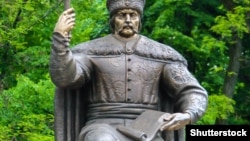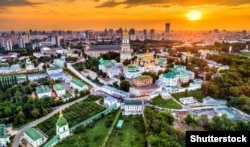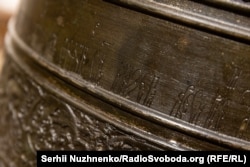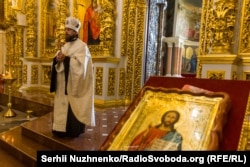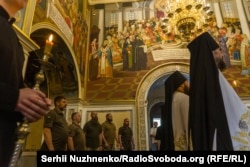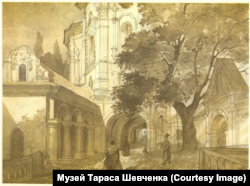As its forces fight to repel a massive Russian invasion, Ukraine is seeking to put its stamp on a sprawling Orthodox Church complex that long loomed over the capital as a symbol of Moscow's influence: the Kyiv-Pechersk Lavra, or Monastery of the Caves.
To aid that effort, the Ukrainian church that threw off the yoke of the Moscow patriarch in 2019 has enlisted the help of Ivan Mazepa, a leader who lived and died over 300 years ago. An icon of independence in Ukraine, his name is anathema in Russia -- literally.
Mazepa, who as Cossack hetman of the Zaporizhian Host was the top leader of a large swath of Ukraine from 1687 to 1708, was a major patron of the church and helped develop the Lavra, a landmark complex of churches, crypts, and related buildings on the steep right bank of the Dnieper River in central Kyiv.
On July 25, a special commemorative service was held at the Lavra to honor Mazepa on the 336th anniversary of his elevation to hetman in 1687. At that time, the Hetmanate was in a union with Russia.
In 1708, however, Mazepa entered a wartime alliance with Sweden against Tsar Peter the Great, earning the lasting ire of Russia, where he is still branded by the state as a traitor, and a reputation as a champion of independence in Ukraine.
The service late last month included the presentation of a bell, now restored, that Mazepa donated to the church centuries ago. It is to be mounted in the Lavra's main bell tower, a prominent feature on Kyiv's skyline and a symbol of the capital.
'Empire Of Evil'
The religious ceremony was attended by dozens of Ukrainian soldiers, a show of unity between the church and the military as the war ground on at the front 17 months after Russia launched its full-scale invasion in February 2022.
"We must restore our common Ukrainian sacred place. And today we are near this bell, a sacred bell that has seen a lot in its history, has overcome a lot, and by the grace of God has been preserved," said Archimandrite Avraamiy, the head of the Kyiv-Pechersk Lavra. "And in our thoughts, we go back to the times of Hetman Ivan Mazepa, who managed the state wisely -- and he wanted the state to be independent and he contributed to that."
"But as always, the Russian empire of evil destroyed those who were against it. And now we are seeing it [again]," he said.
The war has had a major impact on Orthodox Christian life in Ukraine, which had been riven by tension between rival churches aligned with Kyiv and Moscow for decades before the full-scale invasion.
Three years before the invasion, in 2019, the Kyiv-backed Orthodox Church of Ukraine (OCU) was recognized as independent by the spiritual head of all Orthodox Christians, Ecumenical Patriarch Bartholomew of Constantinople, ending centuries of Russian dominance over Ukrainian Orthodoxy.
Religious Rivalry
As Ukrainians band together in the face of the Russian onslaught, the OCU has grown stronger, with hundreds of parishes that had been with the Ukrainian Orthodox Church (UOC), switching allegiance. The UOC, meanwhile, has struggled to distance itself from the Russian Orthodox Church and its leader, Moscow Patriarch Kirill, an ally of Russian President Vladimir Putin and a vocal backer of the war.
President Volodymyr Zelenskiy has described the reduction of influence of UOC as a matter a national security.
The Kyiv-Pechersk Lavra, founded in the 10th century, became a flashpoint this year after Ukrainian authorities ordered the UOC to leave the complex, a UNESCO world heritage site formally in the ownership of the Ukrainian state.
That hasn't quite happened. UOC priests and monks remain but have retreated to the less prominent section known as the Lower Lavra -- and their head, Metropolitan Pavlo, is under house arrest outside Kyiv while state authorities investigate him on suspicion of "inciting religious enmity and justifying Russia's actions."
The OCU has been granted the use of the Upper Lavra and it now holds regular services there.
The church service on July 25 was the second one at the Monastery of the Caves that has been devoted to Mazepa. On June 11, the first liturgy honoring Mazepa was held at All Saints' Church, which was built at the Lavra by Mazepa 325 years ago. It was attended by several senior government officials.
Ukraine's culture minister at the time, Oleksandr Tkachenko, called it a "historic day."
"For the first time in the history of the Kyiv-Pechersk Lavra, a memorial service has been held to honor its patron and sponsor -- Hetman Ivan Mazepa, who was excommunicated by the Russian imperial church during his lifetime for his unwillingness to submit to Muscovy," Tkachenko wrote on Facebook.
"As we promised, the Lavra is becoming Ukrainian. Now, within its walls, we will hear prayers for the famous figures of Ukrainian history," Tkachenko added.
War And Defeat
When Mazepa joined forces with King Charles XII of Sweden against Russia in 1708, during the Great Northern War, the Russian church declared him anathema by personal order of Tsar Peter the Great. Forced to leave Ukraine with Charles XII after Sweden lost the crucial Battle of Poltava in June 1709, Mazepa died a few months later.
This anathema against Mazepa is still technically in place in the Russian Orthodox Church. Ukrainian churches do not recognize it, however, seeing it as political move by Peter to suppress the idea of independent Ukraine rather than a religious step.
To this day, the Russian church and state portray Mazepa as a traitor and a troublemaker. In a report on the liturgy honoring him at the Lavra in June, the Russian state news agency TASS said the service had been organized by the "schismatics" of the OCU, whose legitimacy and independence are not recognized by the Russian Orthodox Church.
"For the betrayal of his oath to Russia, [Mazepa] was publicly punished and stripped of his titles and awards. The Russian Orthodox Church declared Mazepa anathema for violating the oath of loyalty to the Russian tsar, given on the Bible, and also for allowing Swedish soldiers to desecrate Orthodox churches," the TASS report said.
During his tenure in 2005-2010, Ukrainian President Viktor Yushchenko unsuccessfully asked Patriarch Kirill to remove the anathema. With ties between the two countries torn apart by Russia's aggression, it seems unlikely to happen in the foreseeable future.
And Ukraine is unlikely to ask again anyway. Instead, the OCU is honoring Mazepa with liturgies, while he is praised by the country's leadership as a symbol of independence -- and "Europeanness" as well for his union with Sweden, which was a European superpower before it lost the war with Russia following the debacle at Poltava, which is in east-central Ukraine.
At the Kyiv-Pechersk Lavra, Mazepa sponsored and oversaw the reconstruction of the main Assumption Cathedral, built All Saints' Church, several towers, and a wall surrounding the monastery, which was called the Mazepa wall long after his death.
He also built dozens of churches across Ukraine, many in an architectural style sometimes called Cossack Baroque or Mazepian Baroque. Mazepa's colorful life inspired Voltaire, George Byron, Pyotr Tchaikovsky, and Franz Liszt among others.
"Mazepa was the first to show…that he was ready to sacrifice his life for Ukraine. That's why Moscow constantly calls him a traitor. Our nation is a Cossack nation and in the past the part of society which thought about the independence of Ukraine was called Mazepian," Kyiv-based history professor Volodymyr Serhiychuk told RFE/RL.
What's In A (Street) Name?
In addition to two church services to honor Mazepa, activists collected enough signatures earlier this year for an electronic petition to rename the street on which the Lavra is located after Mazepa -- as it was in 2007, under Yushchenko.
That changed under Moscow-friendly President Viktor Yanukovych. Shortly after his election in 2010, on the eve of a visit by Patriarch Kirill, most of the street was renamed Lavrska, leaving only a short two-block stretch far from the complex itself with Mazepa's name.
"Can you imagine what the political situation Ukraine was like back in 2010, when to satisfy Russian Patriarch Kirill, who wanted to come to Kyiv but didn't want the Lavra to be on Mazepa Street, the bigger part of it was renamed Lavrska? This street was never Lavrska before," the author of the petition, Andriy Lupak, told RFE/RL. "It was done to make Patriarch Kirill happy."
"The street was deliberately renamed for the visit of Patriarch Kirill, who didn't want to enter Lavra from Mazepa Street," concurred Kyiv activist Taras Shamaida, who held protests against the renaming in 2010.
Now the Kyiv City Council is looking into the matter, after the petition quickly gained more than 6,000 signatures in March -- enough for it to be considered by local authorities. Lupak, the author of the petition, hopes that the matter will be resolved by the end of the year.
Mazepa was quickly ‘rehabilitated' after Ukraine declared independence and the Soviet Union collapsed in 1991. He soon appeared on the 10-hryvnya banknote.
Since then, Ukraine has erected several monuments to Mazepa, including in Poltava, the site of the battle in which the tsar's victory helped the powerful Russian Empire emerge. Plans to put a monument in Kyiv have been discussed but no decision has been made.
"We have departed from the opinion, which was imposed on us, portraying Hetman Mazepa as a traitor. Mazepa wanted Ukraine to live a free and independent life," Lupak told RFE/RL. "And now, after 300 years, we are fighting for the same things Ivan Mazepa was fighting for."




